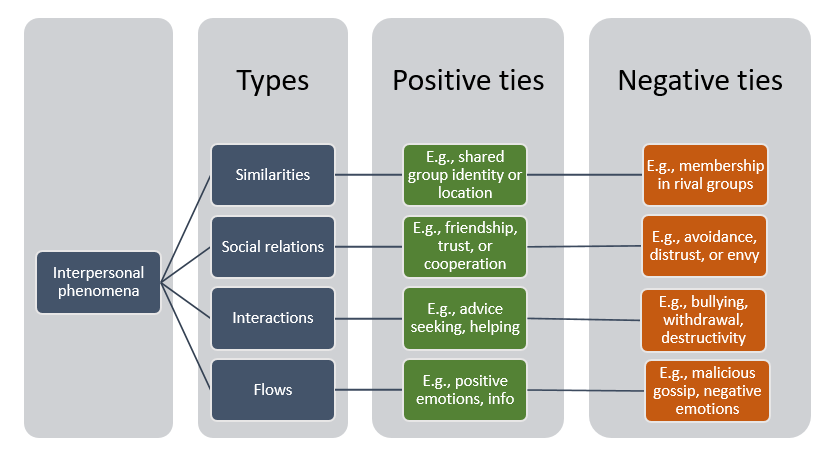Right in the blind spot
Negative relationships in organizational social networks

Conflict, strife, and discord are all very human. Wherever people interact, co-workers bond and friendships blossom, negative relationships appear too. Workplaces are no exception, even if corporate culture makes open hostility taboo. Negative relationships affect almost every feature of organizational life, from internal communication and knowledge sharing to employee retention, from decision-making to change management. As in many other cases, organizational network analysis can help make the invisible apparent
Over the past few decades, there has been an explosion of interest in network research in both management practice and academia. Managers frequently rely on organizational network analysis (ONA) to identify information brokers and influencers who can act as agents of change. They also use ONA tools to recognize cooperation patterns and get a general understanding of how work really gets done in their organizations.
ONA questionnaires usually focus on positive relationships between employees, like trust, sympathy, advice seeking, or knowledge sharing. However, these tools have an arguable blind spot as they typically omit negative ties. Visual depictions of organizational social networks make it quite simple to see if there is no communication between two employees who should work together. The reasons for it might not be so evident. Do they not know each other? Do they have an ongoing conflict or rivalry that ended in avoidance? The difference will matter if you are planning to take action.
Negative relationships are present in every organization, even if corporate culture and an expectedly positive employee attitude make them latent and more challenging to measure. Researchers claim that around 10 percent of all relationships in a social network could be negative, but their overall effect on organizational life is disproportionately higher. This phenomenon is called negative asymmetry. Social psychologists also note that you need 4-5 times more positive feedback than negative to counterbalance their emotionally harmful effect.
What is a negative relationship?
According to Giuseppe Labianca and Daniel J. Brass, network researchers at the University of Kentucky, negative ties in social networks are relatively enduring relationships that induce negative feelings and judgments about, or behavioral intentions towards others. Lasting conflicts, envy, distrust, avoidance, and bullying are among the many interpersonal phenomena present at the workplace that meet this definition.
Whereas positive relationships may generate social capital (resources, benefits, and opportunities accessible through them), negative ties usually appear as liabilities in one’s “social ledger.” Research evidence shows, however, that when considering small groups of people, the detrimental effect of negative ties is not so evident. Even though one or two parties involved in a negative relationship should pay its emotional price, it might prove beneficial for a laughing third. Divide and rule is an old maxim, after all.
Why should you care about negative relationships?
From a network perspective, organizations are sets of actors and social ties that connect them. There are several types of interpersonal phenomena in an organization from relatively static relationships to dynamic interactions and flows. While managers are usually happy to see information, positive emotions, and other resources flow in these social networks, malicious gossips, contagious burnout, and spreading disillusionment might be quite troublesome.
Types of interpersonal phenomena according to Stephen P. Borgatti and colleagues, complemented with examples of negative ties
Negative flows can spread fast in social networks. Everyday life holds many situations where negative emotions can evolve. Minor inconveniences, annoying accidents, and stressful interactions happen. It depends on the employees’ current mood and overall resilience, whether they can cope with or pass on negative emotions. To avoid negative cascades that might seriously undermine engagement and employee satisfaction, managers should take action to make social networks more resilient.
There are many other issues that managers could and should address to reduce the detrimental effects of negative relationships and flows. Enduring conflicts might have a severe impact on individual and group performance. Envy will arise if employees lose trust in organizational justice and how managers distribute promotions and bonuses. Talented people will leave the company if they have too few positive relationships to counteract and help cope with conflicts.
Finding influencers and informal key players can be helpful for effectively conveying messages in internal communication, or in times of change. Having numerous positive relationships, however, does not mean that one cannot be in a central position in the network of negative ties, too. It might turn out that some popular employees are, in fact, divisive and thus less convenient conducts of managerial values and messages. As polls measure politicians both on a scale of approval and disapproval, so should we measure influencers in organizational social networks.
The way people behave in the proximity of a negative relationship in a social network may depend on several factors, including personality. As ancient Greeks had their gods of war (Ares) and deceit (Apate) or goddesses of strife (Eris) and peace (Eirene) on Mount Olympos, so have we similar characters in our modern organizations. Who are the ones that incite conflict to maximize their power? Who are the ones that support others as loyal shield bearers? Who are the ones that do all they can to make peace and bridge division? It takes the dynamic research tools of organizational network analysis to find that out.

Eris tossed the golden apple of discord amid feasting gods at the wedding of Thetis and Peleus (The Wedding of Tethys and Peleus by Jacob Jordaens, 1633)
Negative relationships are usually in the blind spot of managers, consultants, and organizational network researchers. However, gathering more information about their formation will help us create happier and more resilient organizations. When astrophysicists discovered and observed black holes, they got a better and more profound understanding of not only black holes themselves, but of laws and forces of the entire universe. Involving negative relationships in organizational network analysis will establish strategic actions that might lead to higher individual and group performance, higher employee well-being, and, consequently, better retention rates.
Author: Máté Baksa (Ph.D. student at the Corvinus University of Budapest)
This article was originally published here.
Further readings
Borgatti, S. P., Mehra, A., Brass, D. J., & Labianca, G. (2009). Network Analysis in the Social Sciences. Science, 323(5916), 892–895. https://doi.org/10.1126/science.1165821
Labianca, G., & Brass, D. J. (2006). Exploring the Social Ledger: Negative Relationships and Negative Asymmetry in Social Networks in Organizations. The Academy of Management Review, 31(3), 596–614. https://doi.org/10.5465/amr.2006.21318920
Sterling, C. M., & Labianca, G. (2015). Costly comparisons: Managing envy in the workplace. Organizational Dynamics, 44(4), 296–305. https://doi.org/10.1016/j.orgdyn.2015.09.007
Marineau, J. E., Labianca, G., & Kane, G. C. (2016). Direct and indirect negative ties and individual performance. Social Networks, 44(1), 238–252. https://doi.org/10.1016/j.socnet.2015.09.003



